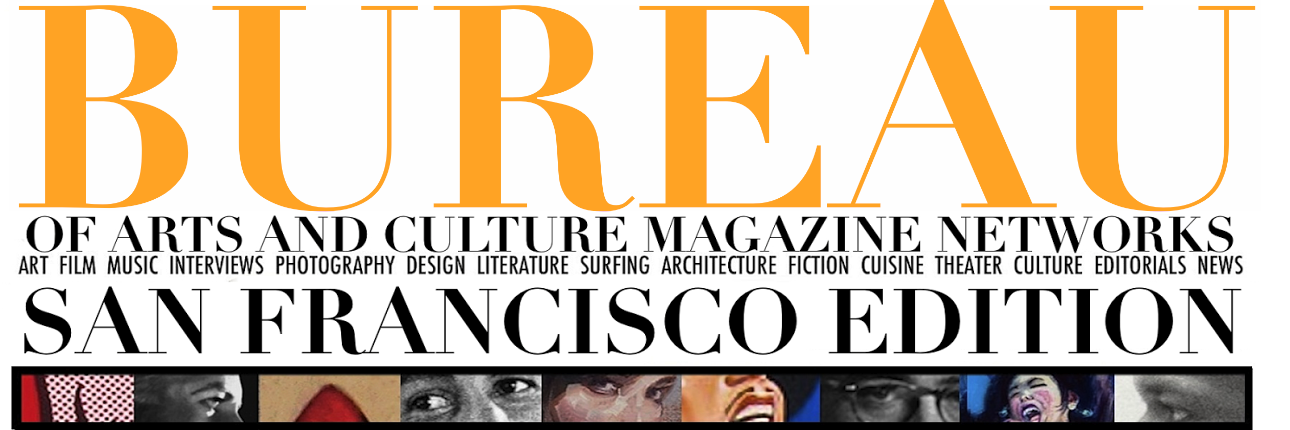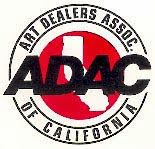" Putting It All Together "

Joshua A. Triliegi's BUREAU of ARTS and CULTURE Magazine The San Francisco Edition is an Affiliate of BUREAU of Arts and Culture NETWORK. We Delivered Paper Editions to Bay Area Residents, Book Stores, Shops, Art Galleries, Record Stores, Salons + More. Now With BUREAU Magazine Sites in New York, MidWest, South, Seattle, LA, Santa Barbara, San Diego, The Literary + NEWS Site. BUREAU Office 323 . 734 . 2877 Download The Exciting 200- 300+ Page E Edition Read by Millions Worldwide.
Pages
- BUREAU of ARTS and CULTURE Magazine San Francisco [ Tap here for Most Recent FREE MAGAZINE EDITIONS]
- ART
- FILM
- BOOKS
- MUSIC
- SPECIAL MUSIC EDITION 2017
- LITERARY 2016 EDITION
- SPRING 2016
- SUMMER 2015 EDITION
- ASIAN EDITION 2015
- LITERARY SPRING EDITION 2015
- FALL EDITION 2014
- WINTER EDITION 2014
- SURF
- PHOTOGRAPHY
- FASHION
- BUREAU EDITORIAL
- BUREAU ICON ESSAYS
- THEATER
- NEW FICTION
- BUREAU NEWS
- SUBMIT BAY AREA EVENTS
- TOURISM
- WRITER J. A. TRILIEGI
Thursday, May 29, 2014
Thursday, May 22, 2014
Monday, May 19, 2014
THE JUNE ELECTRONIC EDITION OF BUREAU OF ARTS AND CULTURE …
CONTACT US FOR DETAILS: BUREAU OFFICE LOS ANGELES 323 734 2877
DOWNLOAD THE ENTIRE MAGAZINE MAY EDITION AT LINKS TO LEFT
Sunday, May 11, 2014
HAPPY MOTHERS DAY INTERVIEW: THE ARTIST & LECTURER JOAN SCHULZE
[ Download The New MAY BUREAU Magazine for Free / link to left ]
ARTIST & LECTURER : JOAN SCHULZE
ART: "I am motivated to do it because I have had an experience that I have to somehow make visual."
BUREAU COMMUNITY SERVICE SITES LOCATED IN:
LOS ANGELES http://BUREAUofARTSandCULTURELosAngeles.blogspot.com
SAN DIEGO http://BUREAUofARTSandCultureSanDiego.blogspot.com
SANTA BARBARA http://BUREAUofARTSandCULTURESantaBarbara.blogspot.com
LOS ANGELES http://BUREAUofARTSandCULTURELosAngeles.blogspot.com
SAN DIEGO http://BUREAUofARTSandCultureSanDiego.blogspot.com
SANTA BARBARA http://BUREAUofARTSandCULTURESantaBarbara.blogspot.com
SAN FRANCISCO http://BUREAUofARTSandCULTUREsf.blogspot.com
NEW YORK CITY http://BUREAUofARTSandCULTUREny.blogspot.com
NATIONAL LITERARY SITE http://TheyCallItTheCityofANGELS.blogspot.com
NEW YORK CITY http://BUREAUofARTSandCULTUREny.blogspot.com
NATIONAL LITERARY SITE http://TheyCallItTheCityofANGELS.blogspot.com

Saturday, May 10, 2014
BUREAU MUSIC: ELMER BERNSTEIN " To Kill a Mockingbird "
Welcome to the Bureau of Arts and Culture's New Monthly Interactive Magazine. Download the magazine at the links to the left. We suggest you view the magazine as a two page layout as some articles have a centerfold photographic design. Many of the features are extended on line in audio, simply tap the links & logos to visit and view images related to the Article. We went door to door with a paper edition last year in the Bay Area and Los Angeles, since then we have added sites in New York City, San Francisco, San Diego and Santa Barbara plus the New National Literature site celebrating all things Literary. Last month, we were proud to have BOB MARLEY on The Cover with a featured Interview with Dennis Morris. This month, we have the Legendary Animator & Artist Jules Engel as our Official Guest Illustrator. Jules Engel transformed animation while working for Walt Disney on the ground breaking film: FANTASIA. Also, Exclusive Interviews with Photographers: Andrew Moore, Matt Schwartz and James Gabbard. We also bring you 10 questions with Filmmaker Tom Donahue, Book Store Owner Dennis Wills And Sculptor Colin Sherrell. We invite you backstage with Mark Murphy at REDCAT, Celebrate Miles Davis' 88Th Birthday, give an excerpt from The 'Chapter-A-Day' Novel: " They Call It The City Of Angels ". Plus a 24 Image Essay, Interviews with Tobey C. Moss & Tony Fitzpatrick, Jack Kerouac's Letters, John Coltrane's Influence at Impulse and Elmer Bernstein's Classic Music for: To Kill A Mockingbird. Tap The Images & Links To Visit Some Of The Institutes. Many of The Ads and Images Are Live Links, so you must be On Line. Send Us an E Mail and You May Win A Complimentary Film From One of Our Advertising Sponsors: FIRST RUN FEATURES. We are also proudly welcoming back INDIE Printing as an Official Advertising Sponsor for The Coming Season. Joshua A. Triliegi Editor - in - Chief
BUREAU MUSIC: To Kill a Mockingbird
Elmer Bernstein's score for To Kill a Mockingbird may just be the most perfect understanding of Literature, Cinema and Musical Orchestration ever created. Mr.Bernstein, who was blacklisted, some years later, made a fabulous comeback with, of all things, his score for John Landis's Animal House. By pulling great musical stunts as a straight man to Landis' pranks. Remember the score to that film ? Heroic like anthems, every time Belushi and his cohorts take on the conservative views of The University. It worked wonderfully and Mr Bernstein was back in business again. I recall meeting Elmer Bernstein at The Academy of Motion Pictures Arts & Sciences, where he presented and discussed To Kill a Mockingbird in - depth. It was quite an evening. A wonderful man. Not just his music, not just his understanding of the human drama, nor his ability to forgive an industry that turned it's back on him, but the man himself. He was a winner and after all these years that score still rings true to me and to millions of cinema lovers around the world. Most folks agree that the book written by Harper Lee and the film by Robert Mulligan and Alan Pakula are incredible. But why ? The acting, yes, quite amazing with performances by two incredible children actors. And of course the apex of Gregory Peck's craft as actor, humanist, artist. But it is indeed the music. The opening theme, a sweeping and steady mid west warmth reminiscent of Mr Bernstein's early influences and one of his mentors: Aaron Copland. Copland encouraged the young musician based on his improvisations and suggested teachers, courses and a direction that led to more creativity.
"The most perfect understanding of Literature, Cinema and Musical Orchestration ever created."
Elmer Bernstein's was a part of a world where, if you were interested in the arts, that meant every facet: he studied acting, dance and performed on Broadway as a child. He was recognized as a painter early on & even approached Clifford Odets on lessons in writing fiction. For over a decade he was a concert pianist and some years later taught at USC's Thornton School of Music. He composed over 200 themes for Television and film and also created some great music for the experimental films of Charles and Ray Eames. He also worked with Martin Scorsese more than a few times. And after his score of Animal house, became a regular for scoring comedies such as Ghostbusters, Airplane! , Stripes and The Blues Brothers.
"Orchestrations that simply lift us above the earth and or break our hearts."
Elmer talked about his inspiration for the score to To Kill A Mockingbird and how he wanted to pierce the imagination of the child mind. What would a child play ? Listening for a simple melody to draw upon. Especially his theme for the foreboding character of Boo Radley, played simplistically by a young Robert Duvall. Keeping the score simple was Mr Bernstein's entire approach to creating the impetus for the melodies and later building them into orchestrations that simply lift us above the earth and or break our hearts. The gentleness, the drama, the curiosity, the fun & the maddening injustices that the world provides, so well presented musically.
" To pull, out of thin air, sounds, melodies, orchestrations,"
" With Mockingbird, I'd read the book. Robert Mulligan and I were old friends, before we even shot a frame. " He goes on to explain, "Aaron Copland was my biggest single musical influence. Apart from my teacher, he was the first person to hear anything I wrote. Copland was good friends with my teacher who took me to meet him in his apartment. I was 12. Copland was 30, but not yet famous. My teacher made me play for him, asking if he thought I had any talent. Let's give him some lessons and find out! ", he replied. That's really how my composition career started."
Imagine that you are given a Pulitzer Prize winning novel and told that it is your job to conjure what it sounds like ? Imagine what these words sound like. To pull, out of thin air, sounds, melodies, orchestrations, themes that represent what a classic book might sound like, that's quite a task. Film composers do it daily. Bernstein employs the flute, violin, harp, clarinet, oboe and strings. For a full review in complete detail, check out the work of Craig Lysy whose done a wonderful job of explaining the score in detail and had this to say about the music, "The main lyrical theme is a masterpiece cue that gains Bernstein immortality. It is timeless and in my opinion takes it place in film score lore as one of the most beautiful and memorable themes ever composed." I couldn't agree more. Heres a link : http://moviemusicuk.us/2010/11/06/to-kill-a-mockingbird-elmer-bernstein/
TO KILL A MOCKINGBIRD Soundtrack Track Listing:
Main Title (3:19) / Remember Mama (1:07)/ Atticus Accepts the Case/Roll in the Tire (2:05)
Creepy Caper/Peek-a-Boo (4:09) / Ewell's Hatred (3:30) / Jem's Discovery (3:46)
Tree Treasure (4:22) / Lynch Mob (3:03) / Guilty Verdict (3:09) / Ewell Regret It (2:10)
Footsteps in the Dark (2:07) / Assault in the Shadows (2:25) / Boo Who? (2:59)
End Title (3:25) / Running Time: 41 minutes 57 seconds
Music composed and conducted by Elmer Bernstein. Performed by The Royal Scottish National Orchestra. Featured musical soloists; Penny Haydock, John Grant, Edward Paling, Pauline Dowse, John Clark, John Cushing, Stephane Rancourt and Christophe Sauniere. Recorded and mixed by Jonathan Allen. Album produced by Elmer Bernstein and Robert Townson.
Other film Scores by Bernstein recognized by The American Film Institute:
The Age of Innocence (1993) / Far from Heaven (2002) / The Great Escape (1963) / Hawaii (1966) / The Man with the Golden Arm (1955) / Summer and Smoke (1961) / Sweet Smell of Success (1957) / The Ten Commandments (1956) / Walk on the Wild Side (1962)
BROUGHT TO YOU BY : SAN FRANCISCO SYMPHONY
Thank You for Your Support Bay Area Readers
Scroll links to the right to see whats doing at The 20th Season …
Thank You for Your Support Bay Area Readers
Scroll links to the right to see whats doing at The 20th Season …
BUREAU COMMUNITY SERVICE SITES LOCATED IN:
LOS ANGELES http://BUREAUofARTSandCULTURELosAngeles.blogspot.com
SAN DIEGO http://BUREAUofARTSandCultureSanDiego.blogspot.com
SANTA BARBARA http://BUREAUofARTSandCULTURESantaBarbara.blogspot.com
LOS ANGELES http://BUREAUofARTSandCULTURELosAngeles.blogspot.com
SAN DIEGO http://BUREAUofARTSandCultureSanDiego.blogspot.com
SANTA BARBARA http://BUREAUofARTSandCULTURESantaBarbara.blogspot.com
SAN FRANCISCO http://BUREAUofARTSandCULTUREsf.blogspot.com
NEW YORK CITY http://BUREAUofARTSandCULTUREny.blogspot.com
NATIONAL LITERARY SITE http://TheyCallItTheCityofANGELS.blogspot.com
NEW YORK CITY http://BUREAUofARTSandCULTUREny.blogspot.com
NATIONAL LITERARY SITE http://TheyCallItTheCityofANGELS.blogspot.com

Subscribe to:
Posts (Atom)









